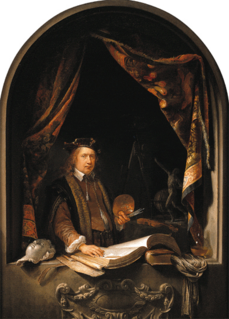
Gerrit Dou, also known as Gerard and Douw or Dow, was a Dutch Golden Age painter, whose small, highly polished paintings are typical of the Leiden fijnschilders. He specialised in genre scenes and is noted for his trompe l'oeil "niche" paintings and candlelit night-scenes with strong chiaroscuro. He was a student of Rembrandt.

Jan Weenix or Joannis Wenix was a Dutch painter. He was trained by his father, Jan Baptist Weenix, together with his cousin Melchior d'Hondecoeter. Like his father, he devoted himself to a variety of subjects, but his fame is chiefly due to his paintings of dead game and of hunting scenes. Many pictures in this genre formerly ascribed to the elder Weenix are now generally considered to be the works of the son.
Rebecca Horn is a German visual artist, who is best known for her installation art, film directing, and her body modifications such as Einhorn (Unicorn), a body-suit with a very large horn projecting vertically from the headpiece. She directed the films Der Eintänzer (1978), La ferdinanda: Sonate für eine Medici-Villa (1982) and Buster's Bedroom (1990). Horn presently lives and works in Paris and Berlin.
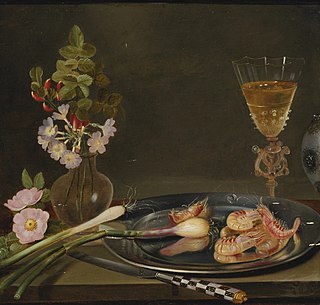
Frans Ykens was a Flemish still life painter active in Antwerp and Brussels in the 17th century. He is mainly known for his flower pieces and fruit still lifes and also painted banquet pieces, pronkstillevens and larger game pieces.

James Sidney Edouard, Baron Ensor was a Belgian painter and printmaker, an important influence on expressionism and surrealism who lived in Ostend for most of his life. He was associated with the artistic group Les XX.
The Tomb of Aline is an ancient Egyptian grave from the time of Tiberius or Hadrian, excavated at Hawara in 1892.

Toyism is a contemporary art movement that originated in the 1990s in Emmen, Netherlands. The word symbolises the playful character of the artworks and the philosophy behind it. The suffix ism refers to motion or movements that exist in both the world of art and religion. Nevertheless, the game of Toyism is a serious matter that shows a new, critical and sensitive perspective on our present-day world.

Mahirwan Mamtani is painter, graphic and multimedia artist.

Asnières, now named Asnières-sur-Seine, is the subject and location of paintings that Vincent van Gogh made in 1887. The works, which include parks, restaurants, riverside settings and factories, mark a breakthrough in van Gogh's artistic development. In the Netherlands his work was shaped by great Dutch masters as well as Anton Mauve a Dutch realist painter who was a leading member of the Hague School and a significant early influence on his cousin-in-law van Gogh. In Paris van Gogh was exposed to and influenced by Impressionism, Symbolism, Pointillism, and Japanese woodblock print genres.
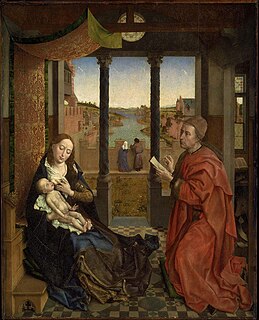
Saint Luke Drawing the Virgin is a large oil and tempera on oak panel painting, usually dated between 1435 and 1440, attributed to the Early Netherlandish painter Rogier van der Weyden. Housed in the Museum of Fine Arts, Boston, it shows Luke the Evangelist, patron saint of artists, sketching the Virgin Mary as she nurses the Child Jesus. The figures are positioned in a bourgeois interior which leads out towards a courtyard, river, town and landscape. The enclosed garden, illusionistic carvings of Adam and Eve on the arms of Mary's throne, and attributes of St Luke are amongst the painting's many iconographic symbols.

The Vrouwenhuis on Melkmarkt 53 in the Dutch city of Zwolle is a former old age home for women. It is now rented as separate apartment units for students, while housing a small museum on the ground floor that is only accessible by special request.

Aleida Greve (1670–1742) was an 18th-century painter from the Northern Netherlands known for founding the Vrouwenhuis, Zwolle.
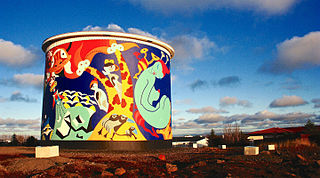
Uppspretta is the name of a Toyist artwork situated in the Icelandic town of Keflavík. In 2013, a neglected water tower being nine meters in height and thirty-six meters in circumference, was transformed into an object of art. The painting shows the story of a puffin named Uppspretta.

Theodoor (Theo) van der Horst, was a Dutch painter, sculptor, graphic artist and glass artist. Van der Horst painted people, animals and landscapes in an expressionist style. Besides oil paintings he made etchings, drawings, gouaches, sculptures and stained glass. He exhibited until the seventies in galleries and museums, but then chose to live as a hermit. He died in October 2003 at the age of 82 in Arnhem.

Sibyl Heijnen (1961) is a Dutch visual artist, part of the second generation after 1960. She graduated from the Gerrit Rietveld Academy in Amsterdam, the Netherlands in 1985. She is known for working with a wide range of materials and techniques, not limited to a particular spatial scale, transcending all boundaries of art.

Jan Hillebrand Wijsmuller was a Dutch painter. He belongs to The 2. Golden Age of Dutch Painting.

Tatjana Doll is a contemporary German painter.

The Trench, but earlier known as Das Kriegsbild or simply Der Krieg, was an oil painting by German artist Otto Dix. The large painting was made from 1920 to 1923, one of several anti-war works by Dix in the 1920s inspired by his experience of trench warfare in the First World War.
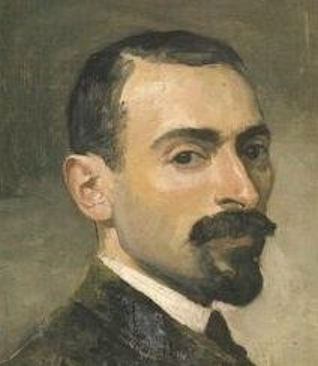
Johan Henri Gustaaf Cohen, known as Johan Cohen Gosschalk was a Dutch jurist, graphic artist and painter of Jewish ancestry. His sister, Meta Cohen Gosschalk, also became a well known painter.





























